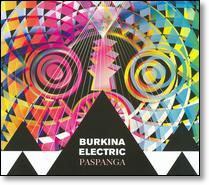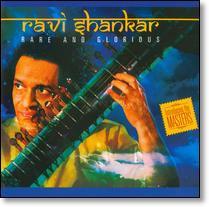A Consumer Guide to the Trailing Edge: March, 2010
Recycled Goods (#72)
by Tom Hull
 |
 |
I've mostly been using Rhapsody to keep up with new stuff I don't get, but it's equally useful for digging into background. I spent a little bit of time looking for old Elvis Presley reissues. His first RCA album, Elvis Presley, was an A+ in the Oct. 2005 Recycled Goods, and I found a couple of follow-up albums that held up pretty well. I was initially looking for reissues of his soundtracks, which are almost by definition dicey affairs, but didn't fare so well there. I also wasn't up to taking on the latest 4-CD Presley box. In general, I find it hard to use Rhapsody for more than one disc at a time -- just too much stuff to keep track of. That's one reason I didn't get to Ravi Shankar's 4-CD In Celebration, although I did manage to sample a lot of his early albums, hoping to provide some context for judging the new Rare and Glorious release. Turns out it is indeed glorious, although there's so much Shankar available it's hard to call any of it rare.
One complaint about Rhapsody is that they didn't have the second volume to the Mississippi John Hurt set below. Fact is, they didn't even have the one I reviewed, although it was at least in the discography. They also didn't have the only one of the six Rick Rubin-produced Johnny Cash records I missed.
Burkina Electric: Paspanga (2009 [2010], Cantaloupe): Another African fusion project where outsiders -- a percussionist with a longstanding taste for African rhythms named Lukas Ligeti, whose father was one of the better known euroclassical avant-gardists, Gyorgi Ligeti, and a German electronics wiz d/b/a Pyrolator -- lands somewhere and hooks up with some local musicians: in this case, guitarist Wende K. Blass and singer Maļ Lingani of Burkina Faso. The only other credits are two dancers, brought in to "help us draw audiences into our unusual rhythms" and thereby validate them. The guitar is less slick than the coast and less rustic than the desert. The vocals are down home, as they should be. A-
Johnny Cash: American VI: Ain't No Grave (2002-03 [2010], Lost Highway): The sixth and reportedly the last offering from Rick Rubin's sessions that started in 1994 with the idea of throwing all manner of pop songs up against Cash's amazing voice. Kind of like batting practice, where Cash aimed for the fences, but just as often fouled one off. At ten songs running 32:18 this is surely the end, not least because Cash's voice has faded into such a soft murmur they wound up putting a child picture on the cover. In a lesser singer, or maybe just a living one, it would be easily dismissed, but there are a couple songs you'll want to hear -- "Cool Water" and "Aloha Oe" -- and a couple you should hear -- "Can't Help but Wonder Where I'm Bound" and "Last Night I Had the Strangest Dream." B+(**) [R]
Mississippi John Hurt: D.C. Blues: The Library of Congress Recordings, Vol. 1 (1963 [2004], Fuel 2000, 2CD): Born in 1892 or 1893, Hurt cut a few records in 1928 then nothing until 1963 when folk musicologist Tom Hoskins rediscovered him, brought him to D.C., to the stage and back into the studio for a remarkable series of recordings up to his death in 1966. His early recordings featured a light, delicate fingerpicked guitar and soft-pedalled vocals, some casually violent, a style which in his 70s settled into pefectly elegant mellowness. For three years, he re-recorded his songbook endlessly, first in the April 1963 sessions available on Rounder as Avalon Blues and Worried Blues 1963, then on these more extensive July sets -- 35 cuts, with a second volume adding 37 more. Then on to the 1964 sessions on Memorial Anthology (Genes) to the 1965-66 Vanguards: the best of the best-ofs is Rediscovered (released in 1998), but they all are amazingly consistent. This one is slightly tentative, with more obscure songs he rarely did, but that's not a complaint. A-
Ravi Shankar: Rare and Glorious (1962-88 [2010], Times Square, 2CD): Born 1920 in Varanasi to a well-to-do Bengali family, Hindu, Brahmin caste. He picked up the sitar, mastered Indian classical music, dabbled in western music, and in the mid-1950s started touring Europe and America. In the mid-1960s the Beatles and the Byrds took an interest in sitar, which meant Shankar, and brought him to a worldwide audience, cemented with his 1967 Monterey Pop Festival performance. Since then he's played everywhere with everyone, but I only occasionally ran into him. Taken by this odds and sods collection, I felt due dilligence was in order before I singled it out from 50 or 100 or 150 titles or whatever his discography adds up to, so I checked out a bunch of them below. Still holds up pretty well. A-
Briefly Noted
Pete Lockett's Network of Sparks Featuring Bill Bruford: One (1999 [2010], Summerfold): Percussion ensemble with Simon Limbrick and Nana Tsiboe on percussion instruments from all around the world for minor beatwise exercises, plus the guest drummer for volume; the skeletal patterns are often intriguing, but they do jump around quite a bit. B+(*)
Elvis Presley: Elvis (1956 [2005], RCA): Second major league LP for RCA, discounting a minor league season at Sun that was if anything more impressive, and supplemented by bonus tracks -- singles like "Hound Dog," "Don't Be Cruel," and "Love Me Tender" that he's more remembered for than the Little Richard covers on the album; still, his throwaways are often worth keeping, since nowadays it takes a song like "Old Shep" to remind you how special he could be. A- [R]
Elvis Presley: Loving You (1957 [2005], RCA): The original 12-cut LP was tied to Presley's second film, but with his movies little more than extensions of his rock persona, this holds up just fine, with a few hits like "Teddy Bear" and masterful interpretations even of songs as well done as "Blueberry Hill." A- [R]
Ravi Shankar: Three Ragas (1956 [2000], Angel): First record, an important milestone in presenting Indian music to the outside world, and in recognizing Shankar as its exemplar; long by LP standards, with the three ragas running 28/10/15 minutes each; intricate, subtle, some stretches where they seem to break into another world. A- [R]
Ravi Shankar: India's Most Distinguished Musician in Concert (1961 [1999], Angel): Live at UCLA's Royce Hall, two long tracks broadly representative of Shankar's meticulous art. B+(**) [R]
Ravi Shankar: Improvisations (1962 [1999], Angel): An early sit-down with some jazz musicians, including Paul Horn, Bud Shank, and Gary Peacock -- not that they make much difference, other than to dilute and distract the star. B+(*) [R]
Ravi Shankar: India's Master Musician (1963 [1999], Angel): Recorded in London at Abbey Road, a significant step toward introducing Shankar and his music to the west; I'm beginning to suspect that non-experts will never be able to make useful distinctions in Shankar's huge catalog, but these five shorter-than-usual pieces are hard to fault, sublime even. A- [R]
Ravi Shankar: Ragas & Talas (1964 [2000], Angel): First side is more of the same, but second side opens with Alla Rakha working a tala rhythm on tabla for five minutes, then finishes with a raga that swells up over 21 minutes into a fiery finish. B+(***) [R]
Ravi Shankar: Portrait of Genius (1964 [1998], Angel): One side of short pieces with flutist Paul Horn only a minor distraction; the other wends its way through the 19:41 "Raga Multani" with the sitar moaning and whining what must be some form of blues, loose over Alla Rakha's tabla. B+(**) [R]
Ravi Shankar: Sound of the Sitar (1965 [2000], Angel): Half solo, half paired with Alla Rakha's tabla, but in both cases the point is to showcase that sitar sound, its twangy string notes wrapped in luscious reverb; still, a tabla beat helps. B+(**) [R]
Ravi Shankar: Live: At the Monterey International Pop Festival (1967 [1998], Angel): This was Shankar's popular breakthrough, putting him on the same stage with breakthrough performances by Jimi Hendrix, Otis Redding, the Who, and many others; starts out very cautiously with a long, elegant piece, followed by a short one much faster, then ending with another long one, this one burning intense -- enough so it made the movie cut. B+(**) [R]
Ravi Shankar: In San Francisco (1967 [2001], Angel): Shankar usually recorded with Alla Rakha on tabla, but this is one of the few albums where the tabla gets out front of the sitar, or more accurately the sitar lays back, resulting in a much thinner sound. B [R]
Ravi Shankar: In New York (1968 [2000], Angel): Practically formula, with Alla Rakha on tabla and Shyam But-Nagar on tamboura, three pieces, the short opener "Raga Bairaga" kicking up a storm, the long closer "Raga Marwa" slow and mesmerizing, with small changes that could go on forever. B+(***) [R]
Ravi Shankar: The Sounds of India (1968 [1989], Columbia): A bit odd in that it starts with a 4-minute lecture on ragas and talas, with further explanations introducing the four pieces; not clear enough to be worth the interruption, but the music is supple and remains mysterious. B+(**) [R]
Ravi Shankar/Yehudi Menuhin: West Meets East: The Historic Shankar/Menuhin Sessions (1967-76 [1999], Angel): Not an even contest, as the legendary classical violinist tries to adapt to Shankar's infinitely flexible grooves -- he does best when he gets a little solo space; otherwise he tends to disappear behind the broad twang of the sitar, although the final cut gets the balance right. B+(*) [R]
Ravi Shankar/Ali Akbar Khan: Ragas (1973 [1990], Fantasy): Khan is a sarod master, almost as famous as Shankar; four 18-20 minute pieces, the sort of thing that originally took a double-LP but now squeezes into a single long CD; the two lead instruments sound similar, but tabla and tamboura help move it all along, even though no one seems to be in much of a hurry. B+(***) [R]
Ravi Shankar: Homage to Mahatma Gandhi (1978-80 [2004], Deutsche Grammophon): Shankar wrote "Raga Mohan Kauns" just days after Gandhi's death in 1948; it opens here, developing a complex propulsion; the other two pieces are less convincing, including a long and rather static tabla solo. B+(**) [R]
Ravi Shankar: Full Circle: Carnegie Hall 2000 (2000 [2001], Angel): At 80 still playing, surrounded by a relatively robust group with daughter Anoushka Shankar as a second sitar player, and little touches like cello to fill things out; seems like they could just be going through the motions, but by the end this fills out nicely, progressively even. B+(***) [R]
The Units: History of the Units: The Early Years (1977-83 [2010], Community Library): San Francisco rock group, cut a couple of albums in the early 1980s, starting as a chintzy keyboard group with a Devo-ish sense of humor which never quite worked; on the other hand, the later instrumental pieces swept up in this archive are catchy in their own right. B [R]
John Vanore & Abstract Truth: Curiosity (1991 [2010], Acoustical Concepts): A brass-heavy big band that has stumbled along over two decades regroups under a reissue of their second album, the leader-trumpeter putting his name on top; lots of section punch and solo swagger. B+(**)
Legend: B+ records are divided into three levels, where more * is better. [R] indicates record was reviewed using a stream from Rhapsody. The biggest caveat there is that the packaging and documentation hasn't been inspected or considered.
Additional Consumer News
Copyright © 2010 Tom Hull.